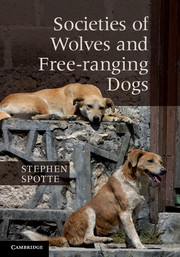
-
Select format
-
- Publisher:
- Cambridge University Press
- Publication date:
- July 2012
- March 2012
- ISBN:
- 9781139057769
- 9781107015197
- 9781107656086
- Dimensions:
- (247 x 174 mm)
- Weight & Pages:
- 0.93kg, 394 Pages
- Dimensions:
- (247 x 174 mm)
- Weight & Pages:
- 0.78kg, 394 Pages
- Subjects:
- Animal Behaviour, Life Sciences, Evolutionary Biology
You may already have access via personal or institutional login- Subjects:
- Animal Behaviour, Life Sciences, Evolutionary Biology
Book description
Wolves are charismatic emblems of wilderness. Dogs, which descended from wolves, are models of urbanity. Do free-ranging dogs revert to pack living or are their societies only reminiscent of a wolfish heritage? Focusing on behavioral ecology, this is the first book to assess societies of both gray wolves and domestic dogs living as urban strays and in the feral state. It provides a comprehensive review of wolf genetics, particularly of New World wolves and their mixture of wolf, coyote and dog genomes. Spotte draws on the latest scientific findings across the specialized fields of genetics, sensory biology, reproductive physiology, space use, foraging ecology and socialization. This interdisciplinary approach provides a solid foundation for a startling and original comparison of the social lives of wolves and free-ranging dogs. Supplementary material, including a full glossary of terms, is available online at www.cambridge.org/9781107015197.
Reviews
'The book is a literal encyclopaedia of information on what makes a wolf, what makes a dog, visual and tactile communication, olfactory and vocal communication, space, foraging, courtship and conception, reproduction and parenting, and socialization. Spotte did a commendable job of synthesizing knowledge on both wolves and dogs which is an enormous task … a valuable reference for anyone’s bookshelf …'
Source: The Canadian Field-Naturalist
'Through mating behavior and litter size, dominance hierarchies, pack membership, genetics, inter-breeding and more, this book explores the wolfish heritage and human influences on dogs, domestic and wild. Students of behavioral ecology will find the detailed research fascinating, and the layperson will enjoy the author’s candid observations about these canid cousins.'
Nancy jo Tubbs Source: International Wolf
Contents
Metrics
Altmetric attention score
Full text views
Full text views help Loading metrics...
Loading metrics...
* Views captured on Cambridge Core between #date#. This data will be updated every 24 hours.
Usage data cannot currently be displayed.
Accessibility standard: Unknown
Why this information is here
This section outlines the accessibility features of this content - including support for screen readers, full keyboard navigation and high-contrast display options. This may not be relevant for you.
Accessibility Information
Accessibility compliance for the PDF of this book is currently unknown and may be updated in the future.


